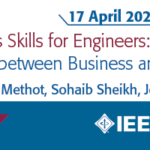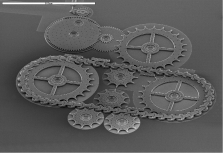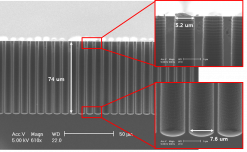Kukjin Chun, IEEE Life Fellow, Professor Emeritus, Seoul National University
A sensor is a device, module, machine, or subsystem that detects events or changes in its environment and relays the information to other electronics, most commonly a computer processor. It is also called as detectors or transducers.
Detection methods include electrical, biological, chemical, mechanical, optical and thermal. Another classification is based on conversion phenomena between input and output: Thermoelectric, Photoelectric, Electrochemical, Electromagnetic, Thermo-optic. The sensor can also be classified according to the detection target, material of the sensor, function and usage: magnetic sensors, chemical sensors, infrared sensors, gas sensors, geo sensors, touch sensing devices, atmosphere sensors, liquid sensors, acoustic sensors, temperature sensors, radiation sensor, proximity sensors, pressure sensors, position sensors, particle sensors, motion sensors, metal sensors, level sensors, leak sensors, humidity sensors, force sensors, flow sensors, flaw sensors, flame sensors, biological sensors, medical sensing devices, vision and imaging sensors, clothes-based sensors.
Particle sensors are common in bin and baghouse monitoring. Key specifications include transducer type, minimum detectable particle size, operating temperature range, sample volume, and response time. Sensitivity, selectivity and stability are increasingly important among key sensor performance characteristics. Sensitivity refers to how much the sensor output changes when the measured target changes, and this is an important factor in determining measurement precision and accuracy. The output of the sensor is changed not only by the measurement target but also by other factors. Selectivity refers to the degree to which the sensor responds more sensitively to the measurement target than other factors. Stability can have a very wide range of meanings, but here we will focus on stability over time. When the measurement target or other factors are constant, the output of the sensor must be constant. However, there is a case where the output changes slightly with time, which is called a drift phenomenon.
A microelectromechanical system type sensor called MEMS is attracting a lot of attention. It is also called MicroMachine or MST (Micro System Technology). In the 1970s, it was already attempted to make a silicon-based sensor, and in the 1980s, simple mechanical parts using the semiconductor manufacturing process began to be manufactured. In the 1990s, sensors and actuators made with MEMS technology began to be installed in automobiles and the devices necessary for RF and optical communications were made in this way, and from the 2000s, the application fields are expanding to devices that enter biological and medical equipment. The most popular MEMS that can be seen around is the head of an inkjet printer, but there are also microphones of smartphones, collision detection sensors for car airbags, and acceleration sensors and gyro sensors that are recently applied to smartphones.
MEMS technology uses semiconductor technology such as thin and thick layer deposition, patterning through photolithography, and etching process to produce necessary shapes. MEMS is made of various materials such as silicon, polymer, metal, and ceramic depending on the purpose or function to be implemented, and the MEMS made in this way is performing new functions and roles by providing a machine-like actuation method at the micrometer level.
Two technologies play a major role in realizing 3D structures in MEMS technology: DRIE and WLVP. Deep reactive-ion etching (DRIE) is a highly anisotropic etch process used to create steep-sided holes and trenches in wafers/substrates, typically with high aspect ratios and also used to excavate trenches for high-density capacitors for DRAM and more recently for creating through silicon vias (TSVs) in advanced 3D wafer level packaging. The wafer-level vacuum packaging (WLVP) technology attaches multiple wafers in a vacuum without using adhesive. Smart sensors were realized by connecting discrete MEMS chips to IC chips through the package but WLVP enables direct interconnection between CMOS IC and sensor elements. The figures below represent gear system made by MEMS technology(left) and SEM image of the micrometer scale deep trench from DRIE technology(right).
For MEMS applications, the sensors used in automobiles will check the function of the vehicle and detect as well as respond to change the conditions inside and outside of the car so that travelers in the vehicle can move with comfort, efficiency, and safety. The sensors employed in the car is airbag sensor, mass airflow sensor, engine speed sensor, oxygen sensor, spark knock sensor, coolant sensor, manifold absolute pressure (MAF) sensor, fuel temperature sensor, voltage sensor, camshaft position sensor, throttle position sensor, vehicle speed sensor, cameras, radar, MEMS gyroscopes, microphones, proximity sensor, fingerprint sensor and tire pressure monitoring sensor(TPMS).
However, the most important sector will be autonomous driving. Advanced Driver Assistance Systems(ADAS) provides an excellent answer to problems such as long-term driving, and transportation at night. LiDAR, radar, and camera detect the surroundings of the autonomous vehicle, and the driver now does not even have to drive while considering the external and internal circumstances. The vehicle control system automatically controls acceleration/deceleration, braking, and steering angles through the sensor data.
Many sensors are also used in autonomous robots including: light sensor, proximity sensor, distance sensor, sound sensor, temperature sensor, contact sensor, pressure sensor, tilt sensor, navigation/ positioning sensor, accelerometer, gyroscope, inertial measurement unit. In today’s fast growing drone market, sensor technologies that power today’s drones are accelerometer, inertial measurement unit, tilt sensor, current sensor, magnetic sensor, engine intake flow sensor, stereo camera and laser range sensor.
Cellphones also employees different types of sensors and actuators and they are pressure sensor, MEMS accelerometer, MEMS gyroscopes, electronic compass, inertial measurement unit, BAW filter, duplexer, MEMS switch, variable capacitor, silicon MEMS oscillator, silicon microphone, optical MEMS for display, CMOS image sensor and MEMS auto focus. Emerging sensors for mobile phones are ambient light sensor, proximity sensor, energy harvesting, micro fuel cell, microspeaker, fingerprint sensor, RFID, temperature sensor, humidity sensor, and gas sensor.
Internet of Things (IoT) is a network of “intelligent” devices with embedded electronics, sensors, and network connectivity that can acquire and exchange data. IoT concepts and technologies have been implemented extensively in automobiles and have been used to create smart lighting in homes and streets and network water, power, temperature control, and alarm systems in cities. IoT applications use large arrays of sensors collecting data for transmission over the Internet to a central, cloud-based computing resource. Analytics software running on the cloud computers reduces the huge volumes of generated data into actionable information for users, and commands to actuators back out in the field.
It will become evident that sensor intelligence, apart from facilitating IoT connectivity, also creates many more benefits related to predictive maintenance, more flexible manufacturing, and improved productivity with low cost, small size, wireless, self-identification and self-validation, very low power, robust, self-diagnostic, self-healing, self-calibrating, and data pre-processing.
The advent of smart-watches and wristbands now allows activities throughout the day to be monitored without creating discomfort for the person, wearable sensing capabilities have been spreading to smart textiles, clothes with embedded electronics, and smart spectacles, increasing the number of parameters that can be monitored, from which patterns and trends can be extracted, to which personalized conditioning or care strategies can be optimized. The sensed data needs to be analyzed and transformed to provide the final feedback to the end user in real time, using artificial intelligence, deep learning, or other techniques to manage “big data”.
References

Kukjin Chun is now a Professor Emeritus at Seoul National University in Korea. He served the Vice-President of IEEE and IEEE Region10 Director. He also served as a General Chair of 2015 IEEE SENSORS Conference and a member of the International Steering Committee of the IEEE International Conference on Solid-State Sensors, Actuators, and Microsystems. He is Life Fellow of IEEE and he received the Order of Science and Technology Merit of Korea in 2017. His research interest is in MEMS and has worked on tactile imagers, distance sensors, physical sensors, micro E-beam modules, RF-MEMS devices as well as bio-MEMS devices. As the principal investigator of the national R&D project of Korean government, he developed a multi-mode, multi-band transceiver systems for mobile WLAN and LTE platform. He has also established an extensive public infrastructure for MEMS/sensor fabrication at Seoul National University which has been used 8000 times per year from 2000.



